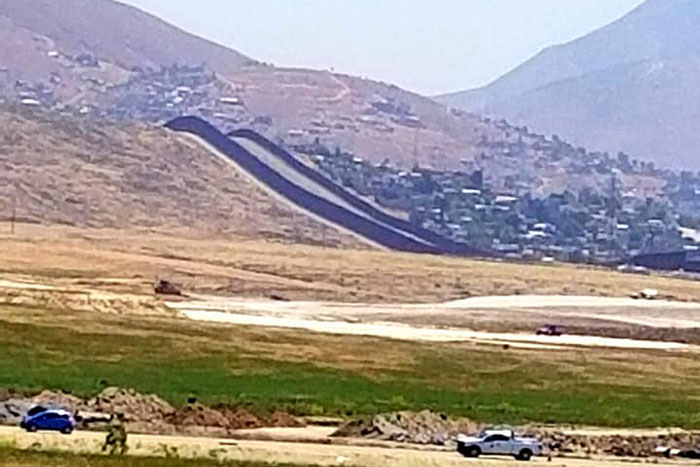Last week I had an opportunity to visit the new US-Mexico commercial border crossing at Otay Mesa, CA – about 20 miles east of the San Diego/Tijuana border crossing. The Otay Mesa crossing was built for trucks and rail crossings at the border, not for people.
There is new construction everywhere on the U.S. side of the border with enormous warehouses, including a new 2.2 million-square-foot Amazon warehouse. All this new development is also creating hundreds of new jobs on the U.S side, for warehouse workers, truck drivers, customs brokers, and other support businesses such as restaurants and truck stops.
From the U.S. side, we could see the looming new black border wall, crawling like an ugly scar across the landscape. Our tour guide said he thought it was pretty useless, as several tunnels have been discovered that runs from Mexico to the U.S., right under the wall. One was discovered recently in a storage yard for wooden pallets a few blocks from the wall. The consensus is that the wall isn’t doing much, if anything, to solve the immigration and illegal drug problem.
But as we looked across the border to the Mexico side, we discovered something surprising. Many of the companies building factories in the commercial areas are Chinese companies! Over the past few years, there has been an increase in investment in factories along the border bankrolled by the Chinese.
When the U.S. withdrew from the Trans-Pacific Partnership in 2017, we left a void that was quickly filled by Chinese investment. Both Mexico and Canada remain in the TPP and have seen Chinese investments grow along their borders with the U.S. Investment is significant in the Maquiladora zones. A maquiladora (also known as a twin plant) is a factory in Mexico, usually near the U.S.-Mexico border, that operates under a favorable duty, or tariff-free basis.
Logistics costs are also a big factor. With trans-Pacific ocean container rates more than doubling in the past few years, plus capacity issues with steamship lines and port congestion, it makes economic sense to manufacture in Mexico. Logistics costs via truck transportation from Mexico are far less expensive.
To avoid the Trump tariffs imposed on China, many Chinese companies have invested in operations in Mexico for products being sold into the U.S. If enough of the value of the product originates in Mexico, goods imported into the U.S. can take advantage of the USMCA free trade agreement (formerly NAFTA) and pay no customs duty. Simply shipping Chinese goods from Mexico into the US without being substantially transformed, does not qualify. Instead, Chinese investors own the factories, but raw materials and parts originate in Mexico. For Chinese companies that are investing in Mexico to the opportunities are enormous.
Chinese factory development and investment on the Mexican side of the border has resulted in job creation in Mexico, but also in the U.S. through logistics operations and support services. While this does not represent growth in U.S. manufacturing, it does represent growth in other kinds of jobs.
As trade relations with China deteriorated under the Trump administration, the Chinese have found other avenues to sell products into the lucrative U.S market, including via the new Otay Mesa crossing.
SC
MR


Latest Supply Chain News
- How CPG brands can deliver on supplier diversity promises
- How S&OP provides the answer to in-demand products
- AI, virtual reality is bringing experiential learning into the modern age
- Humanoid robots’ place in an intralogistics smart robot strategy
- Tips for CIOs to overcome technology talent acquisition troubles
- More News
Latest Podcast

 Explore
Explore
Business Management News
- How CPG brands can deliver on supplier diversity promises
- How S&OP provides the answer to in-demand products
- AI, virtual reality is bringing experiential learning into the modern age
- Tips for CIOs to overcome technology talent acquisition troubles
- There is still work to do to achieve supply chain stability
- Blooming success: The vital role of S&OE in nurturing global supply chains
- More Business Management
Latest Business Management Resources

Subscribe

Supply Chain Management Review delivers the best industry content.

Editors’ Picks




